Finding the sweet spot for a caloric surplus that helps you build muscle without packing on a bunch of fat can be tough, but it’s far from impossible. So if you’re eating to build muscle mass, be sure you read onto the end and we’ll leave no stone unturned.
Creating a caloric surplus is also known as bulking. (make sure to check out that full guide)
A Caloric Surplus Is Not The Same For Every Single Person
The first thing we should get out of the way immediately is that a caloric surplus is exactly what it sounds like. It’s the act of eating more than you burn on a daily basis.
For example, if you burn 2500 calories per day and eat 2900 calories, you’re in a 400 calorie surplus.
Want to gain weight? Eat more than you burn. If you want to lose weight, you have to eat less than you burn. So while this is a simple explanation, weight loss or gain is basic math.

And since a caloric surplus is not the same for all people, there are many factors that determine the size of the caloric surplus, as well as how that surplus affects the individual’s progress.
Here’s a short list of what will determine your total caloric surplus:
- Training experience
- Total amount of muscle gained over time
- Gender (which determines your hormone levels)
- Genetics (which determine muscle belly length, and bone size/structure)
- Training frequency and volume
- How close you are to your genetic limits
- Whether you’re a natural or enhanced (steroids) trainee.
For instance, a seasoned, muscularly-developed individual is going to need fewer calories above their maintenance caloric intake than someone who is just starting out. Another topic we’ll cover is the idea of a so-called perfect surplus and how that surplus will vary the more experience with training and the more muscle you gain over time.
How Experience Levels Will Determine The Surplus
Everyone has a genetic limit that determines how much muscle they can gain over a lifetime. The total amount will be different for everyone but there is a cap as to how much extra lean tissue one can gain.
Later in the article, I cover these numbers in detail.
For now, let’s look at it simply. Men can gain around 40-50 pounds of muscle and women can gain roughly half that over their lifetime assuming consistent training, proper nutrition, average genetics, etc. And to be clear, we’re assuming this person is starting out fresh in terms of their training experience, meaning they haven’t actively tried to gain muscle in the past and don’t have a history of intense resistance training and/or manual labor.
There’s a curve when it comes to the rate of progress and it declines majorly after the first 10-20 pounds of muscle is gained. So while you can make muscle gains fairly quickly in the first few years of training, the rate of progress will sharply decline.
So while a somewhat large (300-500 calories) daily surplus is needed in the beginning, it won’t be needed forever. This is because the more muscle you gain, the harder it becomes to gain more muscle over time. The closer to your genetic limit you get, the harder it will be to make sure the extra weight you gain is muscle and not fat.
Therefore, the more experienced you are, the less food you need above and beyond your maintenance intake is required.
Now I’m not saying that you need to eat less food the more advanced you get. We still need plenty of food to maintain our body’s function and activity levels, but we won’t need as many extra calories.
How Gender Determines The Total Caloric Surplus
First things first: men and women vary greatly in their ability to gain muscle mass over their lifetime. It’s pretty well understood that men have 8-10x the amount of testosterone than women. This is why men are generally larger, have bigger bones/joints, bigger muscles, and more masculine traits such as thick facial hair, body hair, broad shoulders, and sharp jawlines.
Since men naturally produce more testosterone, their genetic potential for more muscle mass is greater than that of a woman. Therefore, the ability for them to synthesize more muscle from a large surplus of calories is greater, and they can manage to eat more food, in general.
So when considering your goals for muscle gain, understanding your genetic ability based on your gender is of great importance.
Our bodies are only able to synthesize so much new muscle tissue within a given time period. So just eating more won’t always translate to more muscle. In fact, eating above and beyond a certain amount will almost always result in more fat gain.
Here are a few guidelines for setting your caloric surplus for men and women.
Caloric Surplus For Men
In general, somewhere between 100-400 calories above maintenance intake per day is a good starting point. Any more than this and the muscle to fat gain ratio is likely to skew toward more fat gain.
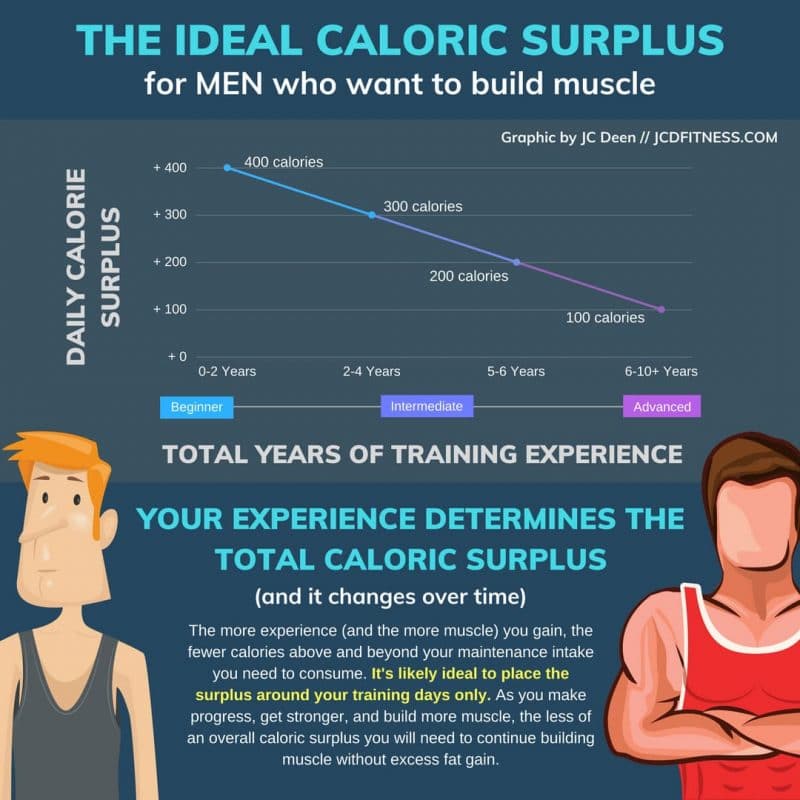
Caloric Surplus For Women
In general, somewhere between 100-300 calories above maintenance intake per day is a good starting point. Any more than this, and the muscle to fat gain ratio is likely to skew toward more fat gain.
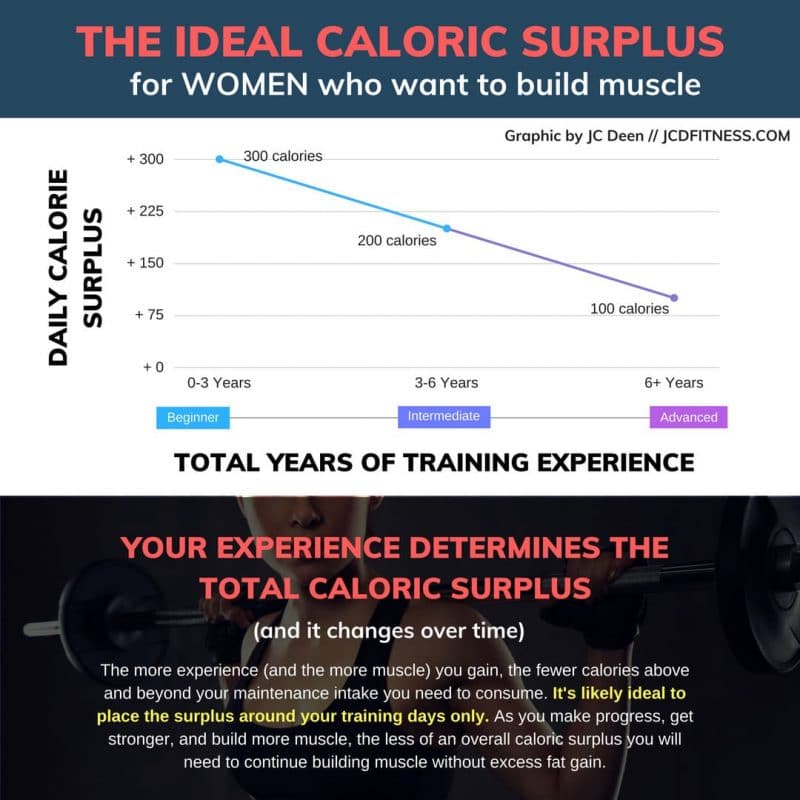
Ideally, you don’t want to gain more than 1 pound of fat for every pound of muscle you gain. While eating everything in sight in the name of muscle gain might seem enticing, it’s a quick way to put on more body fat than you’d hope for and will cut your muscle gain phases shorter than they need to be.
In general, the more time you can spend in an anabolic state (eating a surplus for muscle gain), the more likely you are to add more muscle over time. In short, you don’t want to spend 2-3 months gaining muscle and the other 9-10 months dieting because you gained too much fat.
Other Factors That Influence Rate Of Muscle Gain Are:
Bone, joint, and frame size will greatly affect your ability to build muscle because, the bigger your bones, the more stress from training they can generally withstand. And the more stress you can put on your muscles, the bigger they will become. In general, the biggest bodybuilders and powerlifters all have one thing in common: they have big joints, wide shoulders, and large bone structure.
Muscle Belly Length also factors into the equation of how much muscle you can gain. The longer your muscle bellies, the more potential for growth. For a quick example, take a look at the calf muscle, or your biceps muscle. The length of the actual muscle belly (the contractile tissue, not including the tendon) will determine how big it can get.
Some people have calf muscles that seem to go from the back of the knee all the way down toward their ankle. And some people’s calf muscles stop near the middle of their lower leg, or worse, close to the back of the knee. When your muscle bellies are shorter, your ability to build muscle will be limited naturally by genetics.

Hormone Levels, such as testosterone, cortisol, stress hormones, and thyroid (among others) will influence how much muscle you can gain, and the types of food, plus the amount you eat will influence the hormonal state of your body.
Since we’re only focusing on the ideal caloric surplus, we’ll cover these other factors in more depth another time. Just remember that food determines whether or not you’re in an anabolic (muscle building) or catabolic (muscle wasting) state.
How To Setup Your Caloric Surplus: Determine Total Calories First
The very first thing you must do before setting up a caloric surplus is to establish your maintenance calories. If you don’t understand your maintenance intake, you won’t actually know if you’re eating enough, too much, or too little.
You can use our calorie intake calculator below to determine your maintenance intake (just input your stats!)
Determine Macronutrients
Once you know your maintenance calories, you should then set up your macronutrient ratios. If you’re not familiar with what macronutrients are, check out what are macros?
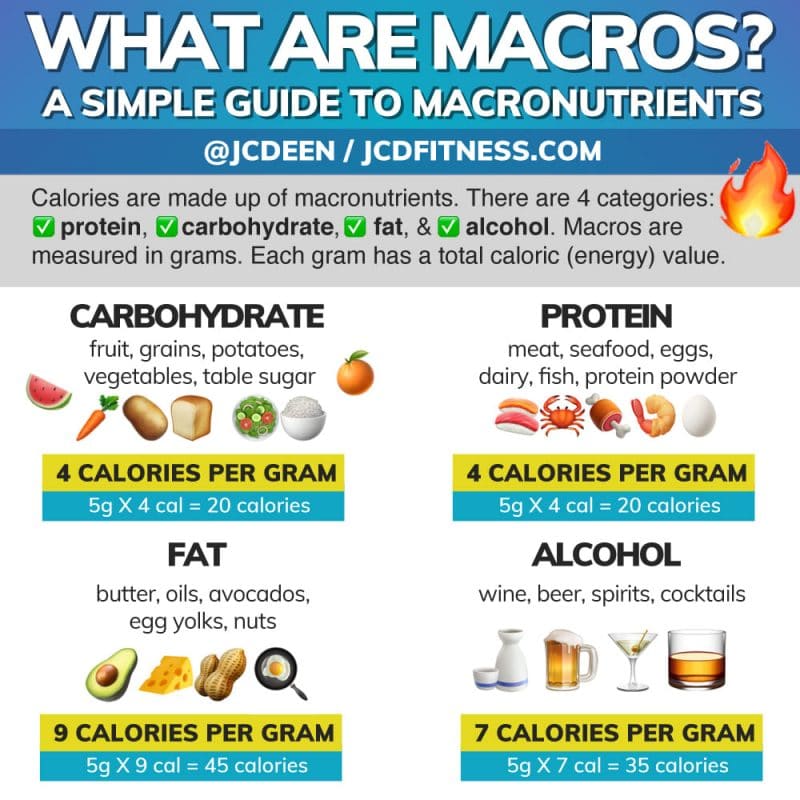
For this example, we will use the stats for men taken from the image above. Let’s say he’s 180 pounds with a maintenance intake of 2500 calories. He decides to create a 300 calorie surplus, for a total of 2800 calories.
To establish the total macronutrient recommendations for a caloric surplus, I like this formula:
Protein: 1 multiplied by body weight in pounds (or 2.2 multiplied by body weight in kilograms). For more information, check out how much protein do you need and my how to eat more protein articles.
Fat: 20-25% of total calories.
Carbohydrates: remaining calories left in the caloric surplus intake.
To put this all together, here’s how the math works:
Protein: 180×1 = 180 grams. 180 x 4 = 720 calories. (1 gram of protein equals 4 calories)
Fat: 20% of 2800 calories = 560 calories. 560 / 9 = ~62 grams of fat. (1 gram of fat equals 9 calories)
Total calories so far: 720 + 560 = 1,280
Carbs: 2,800 – 1,280 = 1,520 calories left over. 1,520 / 4 = 380 grams. (1 gram of carbohydrates equals 4 calories)
Official Caloric Surplus macronutrient ratio:
Protein: 180 grams
Fat: 62 grams
Carbohydrates: 380 grams
Why Keep Fat Relatively Low?
The main reason is due to something called calorie partitioning.
In general, dietary fat is easily stored in the body because there is no conversion process. Carbohydrates and protein can both be stored as fat but it must go through a conversion process in the body. I cover this more in this article: is sugar bad for you and making you fat?
When we’re consuming a caloric surplus, we’re always going to be storing some of those calories as fat, so I prefer to aim to limit this as much as possible and to do that, we should not overfeed too much on fat to create the caloric surplus.
Here’s A Hack For Gaining More Muscle And Less Fat
The holy grail of changing your body composition is to gain tons of muscle without gaining fat. While that sounds amazing, it’s just not in line with reality. You will gain some fat along with the muscle you put on. It’s just part of the process.
However…
You can put on muscle without becoming overly fat in the process. And that’s by making sure you only eat a caloric surplus on the days you train.
So if you have determined you need a 300 calorie surplus, you will create that surplus on the days you train. As per the example above… if your 300 calorie surplus puts you at 2800 calories for the day, you would eat 2800 calories only on training days.
On the days off of training, you would consume your maintenance intake of 2500 calories.
By doing it this way, you will keep from gaining unnecessary amounts of fat while adding lean muscle. But please know that you will likely gain some fat during this process. Trying to add nothing but lean muscle tissue is a recipe for not making progress.
Be Mindful Of Slow To No Progress
Avoid the pitfall of trying to stay super lean without any fat gain as it’s a recipe for disaster. But this doesn’t mean to go on a perma-bulk (forever eating and gaining weight without dieting).
Most people will delude themselves into thinking they can gain lean muscle mass only by eating fewer calories on off days and increasing their intake on training days. But instead of using the model I’ve proposed, they will attempt to put themselves into a caloric deficit on off days while overeating on training days.
And while this can work theoretically, it hardly pans out in the manner one would hope for. Gaining muscle is a difficult process and only gets harder the more advanced you get. No one magically builds muscle and it rarely happens on accident.
The last thing you want to do is look back over 12 weeks wishing you’d eaten more and accepted some fat gain in the name of building muscle.
Avoid Cheat Days Or FOMO Days
On any diet that calls for a caloric surplus, you should be careful of so-called cheat days or FOMO (fear of missing out) days where you eat anything and everything in sight. This is especially true if you’re trying to monitor your total caloric surplus to keep fat gains to a minimum.
If you’re looking to have a favorite meal out or enjoy some of your favorite desserts, simply work it into your caloric intake and do your best to fit it into your macros.
Beware Of These Common Pitfalls:
‘Get Stronger And You’ll Build Size’
While this advice is not too bad, just focusing on strength-related types of training is not likely to give you the best gains in muscle mass. To build muscle, we need a combination of:
- Mechanical tension
- Metabolic Stress
- Muscle damage
See my article on muscle hypertrophy to get a full education on how to build muscle properly.
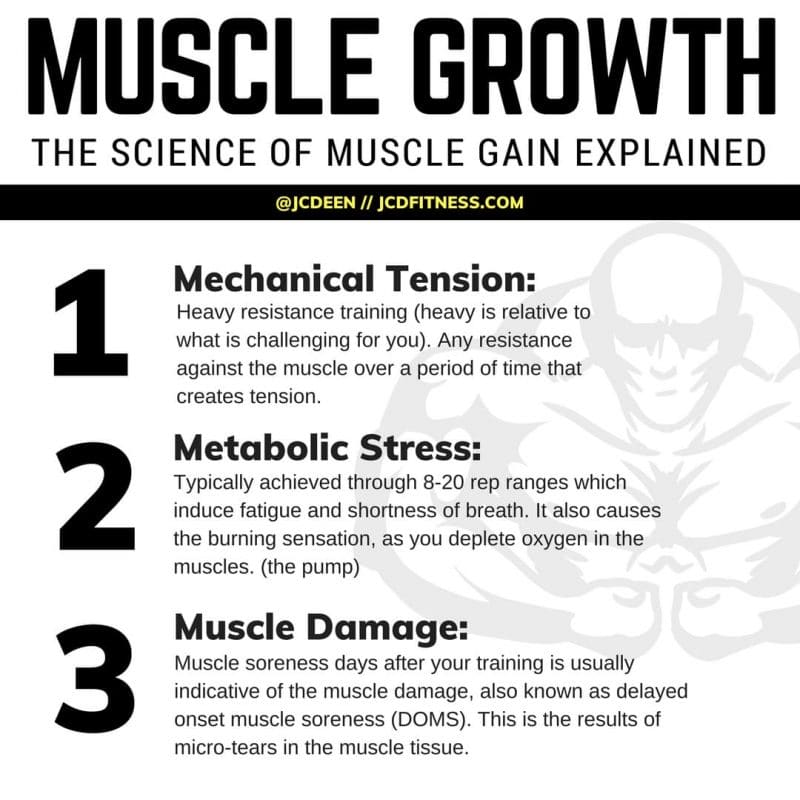
While getting strong should be a goal of yours, it’s not the only goal. There are plenty of people who are very strong but not overly muscular. Just training for strength will build muscle, but it won’t build the maximal amount of muscle possible.
More Food = More Muscle
This is a common logical fallacy we’ve all fallen prey to at one point or another. The idea is that we can eat all the food we want, train really hard, and we’ll grow bigger and bigger with more muscle than ever before.
However, the body can only build so much muscle tissue at once and the more muscle mass you gain, the slower the body can build new muscle tissue. As a result, only so much food will be used for building muscle, and the rest of the food will go toward fat gain.
A quick example goes like this:
If you chose to eat a 1000 calorie surplus, something like 200-300 calories would go to building new muscle and the other 700-800 calories would go straight to fat storage. This is why extreme weight gainer shakes and diets like GOMAD are a horrible idea if you care anything about maintaining some level of leanness while building muscle.
This Process Gets Infinitely Harder With Time
I hate to break it to you, but it’s true. The longer you train, the more muscle you gain, the bigger you get, the harder it will become to add more muscle and not just get fat. And this leads to the next point…
You Level Of Caloric Surplus Changes Over Time
The more advanced you become, the smaller your caloric surplus needs to be. Everyone has their own unique maintenance calorie requirements, but how much you eat above and beyond that intake will be determined by how much muscle you’ve gained in your lifetime.
The So-Called ‘Genetic Limit Is Real
If you don’t get anything else from this article, you must know this: your potential for muscle gain has a limit. Contrary to what you may have been told, or led to believe by muscle magazines, fake natural bodybuilders on Instagram, or anywhere else in the media, you cannot build an infinite amount of muscle. Your body is naturally equipped to handle a certain level of muscle mass and that’s that.
There are NO magical supplements, workout plans, or special routines that will allow you to blow past your limits. The only supplements that will allow you to surpass your genetic limits are anabolic-androgenic steroids (AAS).
Your body maintains a natural level of circulating anabolic hormones (such as testosterone and dihydrotestosterone) and those are largely determined by your environment, stress levels, caloric, macro, and micronutrient intake.
To increase your androgen levels above and beyond natural limits will require the use of steroids, which are beyond the scope of this article, not to mention I have zero experience with them.
Now that we’ve gotten the bad news out of the way, your maximum muscle potential (natural genetic limit) is dictated by the following factors:
- Bone/joint size (the overall size of your body frame)
- Muscle belly length, which determines how strong you can ultimately get
- Hormone levels (testosterone, thyroid levels, among others)
To put this in plain language, your ability to gain muscle mass diminishes over time the bigger and stronger you get.
When I was a few years younger, I believed that with a lot of willpower, hard work, attention to detail, and perfect diet, I could get as big and lean as my bodybuilding heroes. But once I learned about Casey Butt and read his book about the Maximum Muscular Potential, I realized I was caught up in the lies of the fitness industry.
In short, here’s a good timeline of what’s to be expected for muscle gain for the natural lifter below.
Muscle Gain Potential For Men:
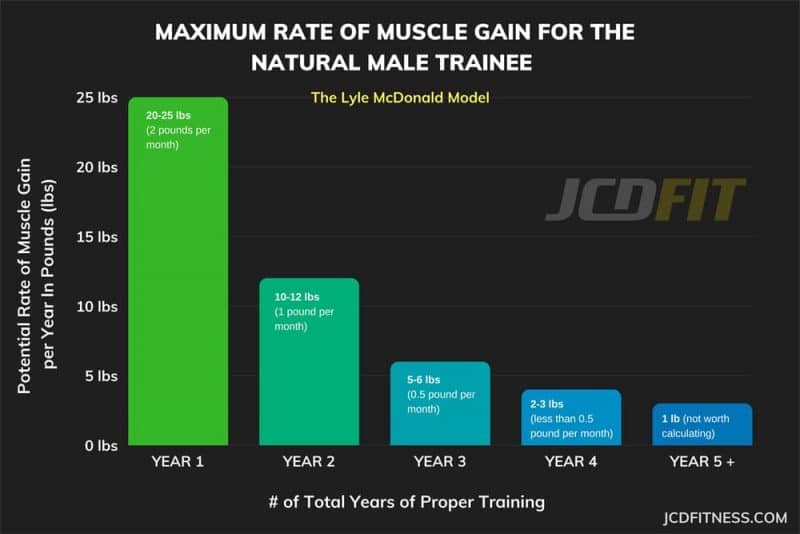
Muscle Gain Potential For Women:
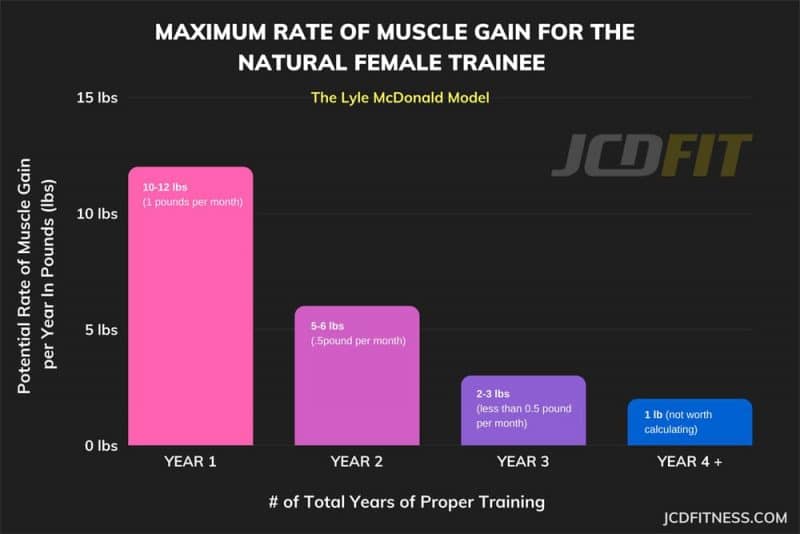
These images were created based on Lyle McDonald’s model of the genetic limits for maximum muscular potential. There are various models but they’re all very similar in the conclusions for the maximum amount of muscle one can gain.
Since there’s a genetic limit to how much muscle we can gain, we need to be realistic with our rates of progress.
The only way to go above and beyond the genetic ceiling for muscle gain is to take androgenic anabolic steroids. I’ve never taken steroids, so I cannot give recommendations on this… just know that when you take these drugs, you expand your genetic limits.
Also, this is why it’s so discouraging when you’re flipping through Instagram and you see these massive, lean bodies of individuals who make the claim they’re lifetime natural trainees when in reality, they’re not.
Lastly, This Is Not An Exact Science Or Math Equation
It’s common to think you can just plug in some numbers and get the perfect formula, but some people need a lot of food before they start to gain weight due to N.E.A.T. (non-exercise activity thermogenesis, you can read more about that here.) and others don’t need a ton more. This is all about figuring out the sweet spot of gaining the right amount of weight so you don’t get too fat in the process of building your best physique.
